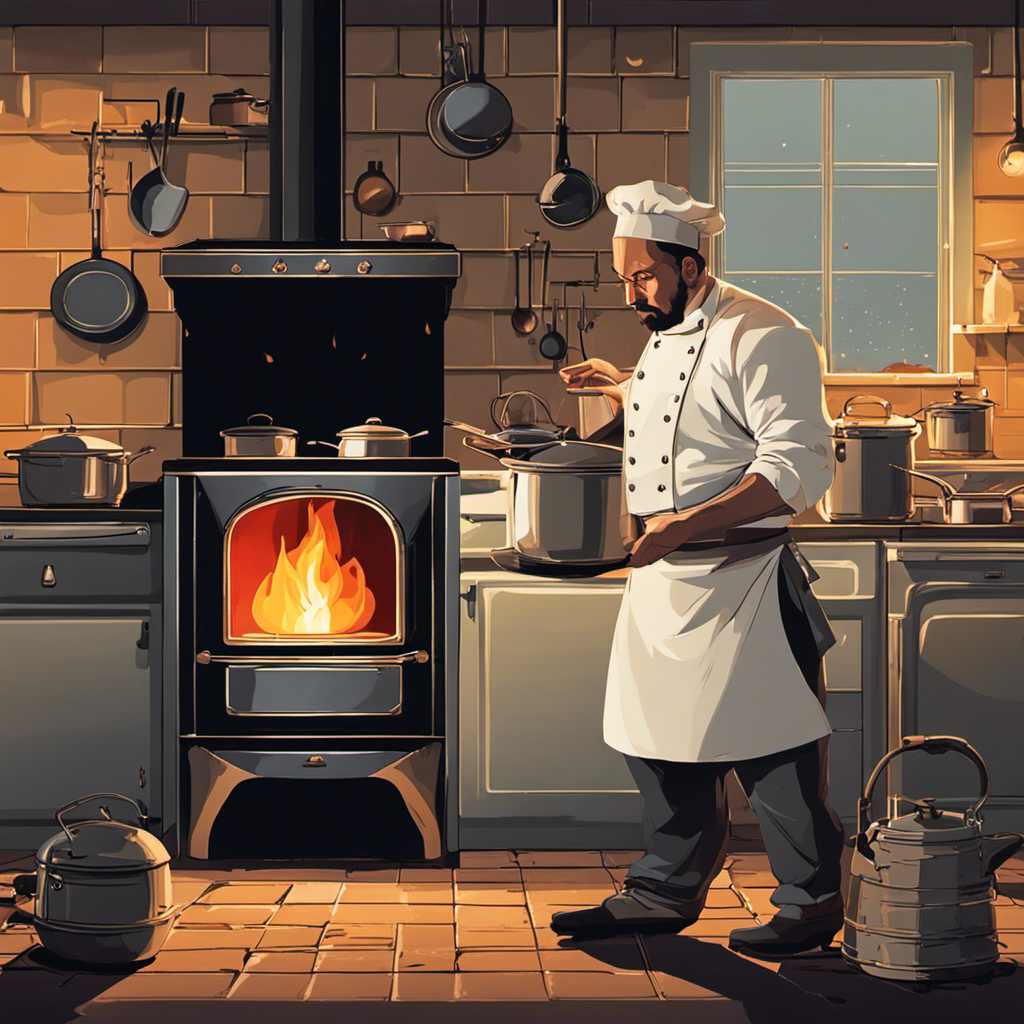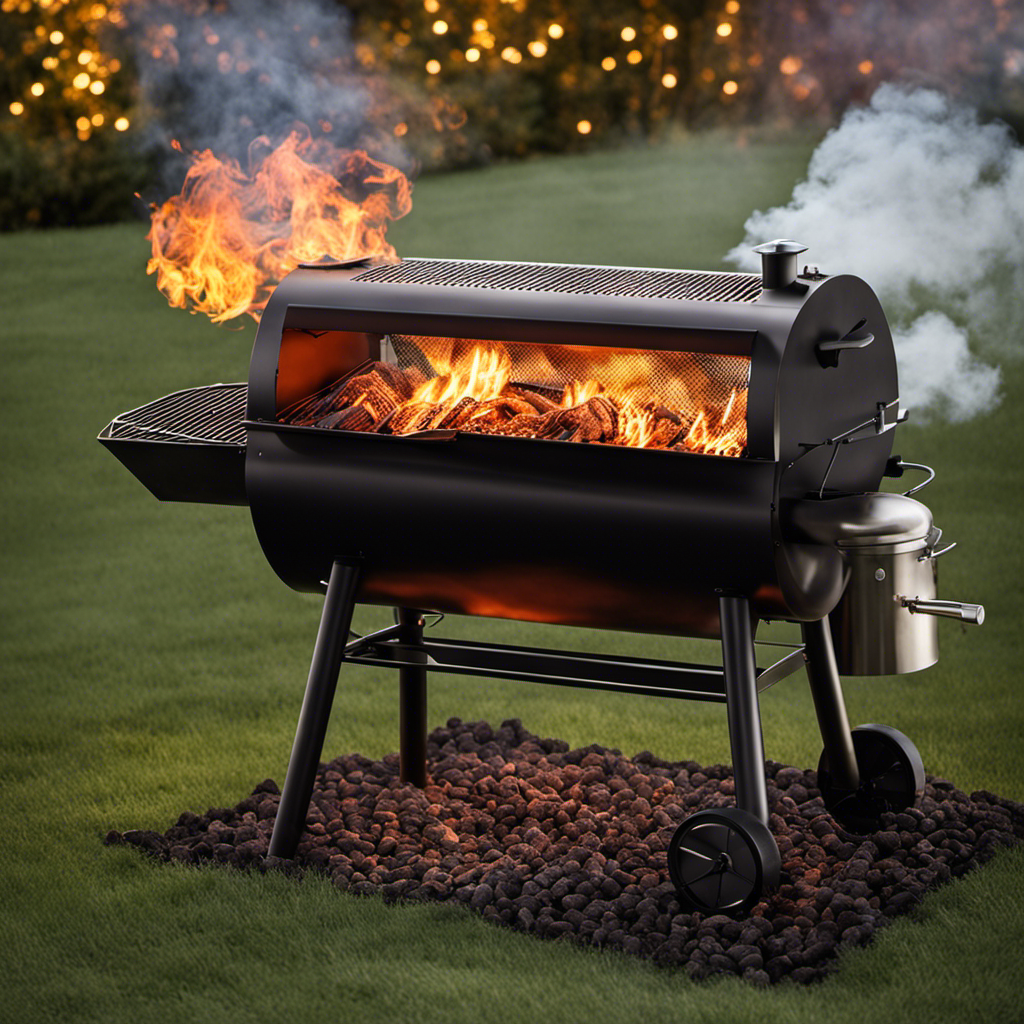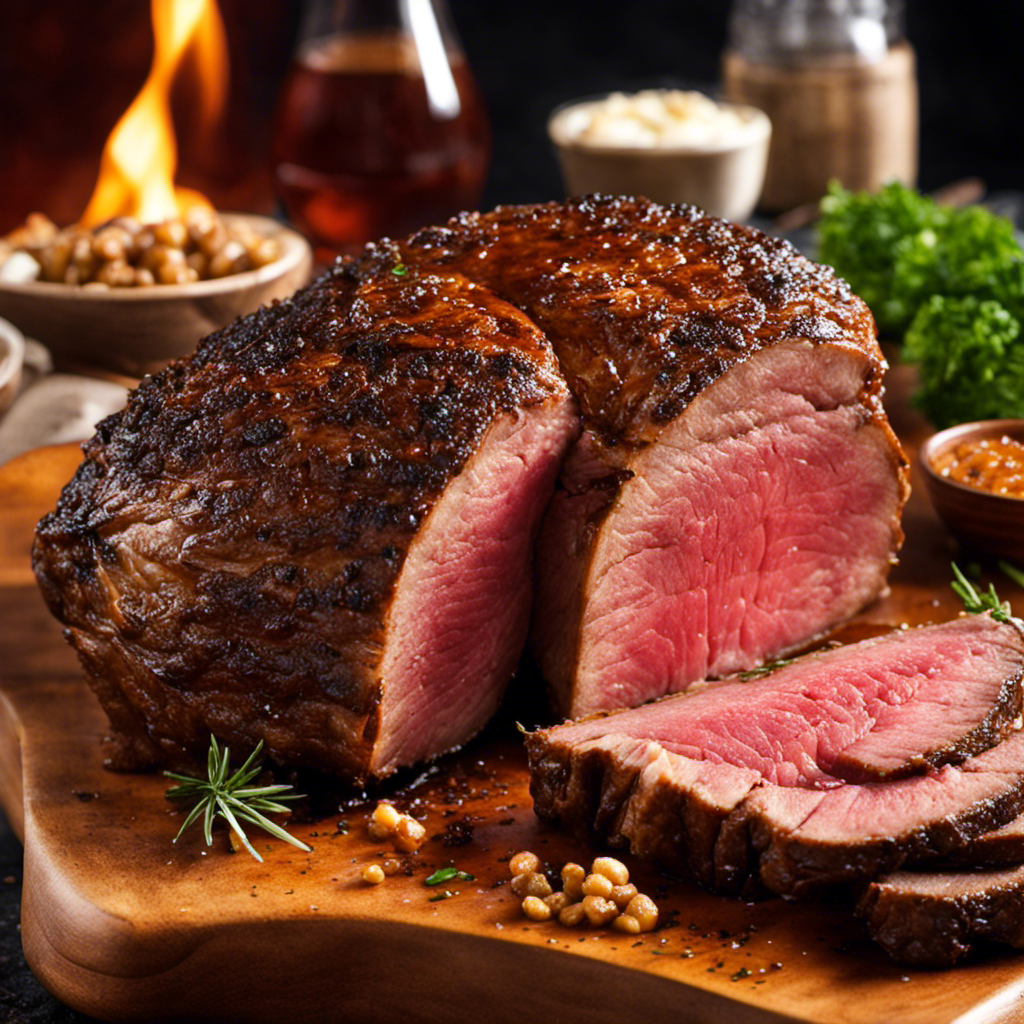Are you prepared to stay snuggled up and warm throughout the chilly season? We have exclusive insights on the warmth produced by pellet stoves and strategies to ensure your safety while operating them.
Pellet stoves are not only efficient and environmentally friendly, but they also provide relief for those with allergies. Rest assured, with their safety features and proper precautions, pellet stoves are a reliable and secure choice for heating your home.
So, let’s dive in and discover the truth about pellet stove heat!
Key Takeaways
- Pellet stoves are efficient and environmentally friendly heating systems that use compressed wood or biomass pellets.
- They are low-maintenance and easy to operate, making them a convenient option for homeowners.
- Pellet stoves have safety features such as automatic shut-off, flame barriers, and cool-to-the-touch exteriors to ensure user safety.
- Proper ventilation and regular cleaning are crucial to prevent fire hazards and carbon monoxide poisoning.
How Pellet Stoves Work
Pellet stoves burn compressed wood or biomass pellets, which are fed into the stove via an auger. Understanding pellet stove technology is crucial to appreciating the advantages of pellet stove heating.
These stoves are highly efficient and use less fuel compared to traditional heating systems. This not only helps reduce heating costs but also benefits the environment by producing minimal emissions.
Pellet stoves are an excellent choice for people with allergies as they don’t circulate dust or pollen. They’re relatively low-maintenance and easy to operate. With safety features like automatic shut-off and screens to prevent contact with the flame, pellet stoves are generally safe when used properly.
Benefits of Using a Pellet Stove
Using a pellet stove can help us save on heating costs while being environmentally friendly. Here are some benefits of using a pellet stove:
-
Efficiency: Pellet stoves are highly efficient and use less fuel compared to other heating systems, which can help reduce heating costs.
-
Allergy-friendly: Pellet stoves don’t circulate dust or pollen, making them a great choice for people with allergies.
-
Environmentally friendly: These stoves produce minimal emissions and burn renewable biomass pellets, making them an eco-friendly heating option.
To ensure the longevity and safety of your pellet stove, regular maintenance is crucial. It’s important to clean the stove regularly to prevent fire hazards and ensure proper functioning. Additionally, professional installation is recommended for proper venting and safety compliance.
Efficiency and Fuel Savings
When it comes to efficiency and fuel savings, we can definitely see the benefits of using a pellet stove. These stoves are known for their high fuel efficiency, which means they can heat a space using less fuel compared to other heating systems. This is great news for both the environment and your wallet.
Pellet stoves achieve this impressive fuel efficiency by burning renewable energy sources, such as compressed wood or biomass pellets. These pellets are made from sustainable materials, making them an eco-friendly choice. By using renewable energy sources, pellet stoves help reduce our dependence on fossil fuels and contribute to a more sustainable future.
Allergy-Friendly Heating
One of the major benefits of using a pellet stove is that it doesn’t circulate dust or pollen, making it a great option for people with allergies.
- Pellet stoves improve indoor air quality by reducing the presence of allergens in the air.
- They burn clean, producing minimal emissions that can irritate allergies.
- Pellet stoves are more efficient than traditional heating systems, reducing energy consumption and saving on heating costs.
Pellet stoves are a fantastic choice for individuals who suffer from allergies. Unlike other heating systems, pellet stoves don’t circulate dust or pollen, which can trigger allergic reactions. This means that individuals with allergies can enjoy a warm and cozy environment without worrying about their symptoms being exacerbated.
Additionally, pellet stoves contribute to better indoor air quality by reducing the presence of allergens in the air. This is due to the clean burning process of pellet stoves, which produces minimal emissions that can irritate allergies.
Furthermore, pellet stoves are more efficient than traditional heating systems, resulting in lower energy consumption and reduced heating costs. With their allergy-friendly features and energy-saving capabilities, pellet stoves are an excellent choice for individuals looking to improve their indoor air quality while keeping warm and cozy.
Environmental Friendliness
Another advantage of pellet stoves is that they contribute to a cleaner environment by producing minimal emissions. Pellet stoves burn compressed wood or biomass pellets, which are a renewable energy source. Unlike traditional heating systems that rely on fossil fuels, pellet stoves release fewer pollutants into the air, reducing their environmental impact.
By using renewable energy sources, such as wood pellets, we can help reduce our dependence on non-renewable resources and decrease our carbon footprint. Pellet stoves also have higher efficiency ratings compared to other heating systems, meaning they convert more of the fuel into usable heat.
This not only saves energy but also reduces the overall environmental impact. Choosing pellet stoves as a heating option isn’t only beneficial for your home but also for the planet.
Low-Maintenance and Easy Operation
Maintaining and operating a pellet stove is hassle-free, requiring minimal effort and providing convenience for us. Here are the low maintenance benefits and ease of operation for beginners:
-
Low Maintenance Benefits:
-
Pellet stoves are relatively easy to clean, with minimal ash residue compared to traditional wood stoves.
-
The pellet fuel is stored in bags, eliminating the need for chopping and storing firewood.
-
Pellet stoves have self-cleaning mechanisms that reduce the frequency of manual cleaning.
-
Ease of Operation for Beginners:
-
Pellet stoves have user-friendly controls, making it easy to adjust heat settings and ignition.
-
They often come with programmable thermostats, allowing you to set desired temperatures for different times of the day.
-
Many pellet stoves have automatic ignition systems, eliminating the need for manual lighting.
With their low maintenance requirements and user-friendly operation, pellet stoves are an excellent choice for beginners looking for a convenient and efficient heating solution.
Cost Savings With Pellet Stoves
Using a pellet stove can save us money on heating bills due to their efficient fuel consumption. When compared to traditional heating systems, pellet stoves provide a cost-effective solution.
Traditional heating systems rely on fossil fuels, which can be expensive and subject to price fluctuations. In contrast, pellet stoves burn compressed wood or biomass pellets, which are more affordable and readily available.
Additionally, pellet stoves are a sustainable heating option with minimal environmental impact. They produce minimal emissions and use renewable biomass fuel sources. By choosing a pellet stove, we can decrease our carbon footprint and contribute to a greener future.
Not only do pellet stoves offer cost savings, but they also provide a sustainable heating solution for our homes.
Safety of Pellet Stoves
When properly operated and maintained, pellet stoves offer peace of mind in terms of safety for our homes. Ensuring the safety of your pellet stove is crucial to prevent any accidents or problems.
Here are some common pellet stove problems and pellet stove installation tips to help you stay warm and safe:
-
Common pellet stove problems:
-
Ignition issues: If your stove isn’t igniting properly, check the fuel supply and the igniter for any blockages or damage.
-
Poor heat output: This could be due to a dirty stove or improper ventilation. Regular cleaning and proper airflow are essential.
-
Auger jams: If the pellets aren’t feeding properly, it could be a sign of an auger jam. Clean or replace the auger if necessary.
-
Pellet stove installation tips:
-
Choose the right location: Install your stove in a well-ventilated area away from flammable materials.
-
Follow manufacturer’s instructions: Proper installation is crucial for safety and efficiency.
-
Ensure proper clearance: Maintain the recommended clearance from walls and furniture to prevent heat damage.
Important Safety Features
One important safety feature of pellet stoves is the automatic shut-off if they overheat, providing peace of mind and preventing potential accidents. This feature ensures that the stove doesn’t reach dangerous temperatures that could lead to a fire or other safety hazards.
However, it’s important to note that relying solely on this safety feature isn’t enough. Regular maintenance is also crucial to ensure the safe operation of pellet stoves. One common misconception about pellet stoves is that they require minimal maintenance. In reality, regular cleaning is necessary to prevent fire hazards. Built-up pellets can ignite and cause a dangerous situation.
Therefore, it’s essential to clean the stove regularly and follow the manufacturer’s instructions to maintain its safety features and prevent accidents.
Proper Maintenance for Fire Prevention
Regular cleaning and following the manufacturer’s instructions are essential to prevent fire hazards and maintain the safety features of our pellet stove.
To ensure proper fire prevention maintenance, it’s important to follow these cleaning procedures:
- Clean the ash trap regularly to prevent buildup and ensure proper airflow.
- Remove and clean the exhaust vent to prevent blockages and maintain efficient operation.
- Clean the glass door to remove any soot or residue that can obstruct the view of the flames.
By regularly cleaning these key areas of the pellet stove, you can prevent fire hazards and maintain the safety features.
Additionally, following the manufacturer’s instructions for cleaning procedures will ensure that you’re properly maintaining your pellet stove and maximizing its lifespan.
Tips for Using Pellet Stoves Safely
To ensure our well-being, it’s crucial that we prioritize proper ventilation when operating a pellet stove. Proper ventilation is essential for preventing carbon monoxide buildup, which can be deadly. Carbon monoxide is a colorless, odorless gas that can be produced by incomplete combustion in the stove.
Make sure that the exhaust vent is clear and unobstructed to allow for the safe release of gases. Additionally, regular cleaning and maintenance of the pellet stove is necessary to ensure its safe and efficient operation. Clean out the ash pan regularly and remove any built-up pellets that can catch fire. Follow the manufacturer’s instructions for safe operation and always have a smoke alarm and fire extinguisher nearby in case of emergencies.
Frequently Asked Questions
Are Pellet Stoves Suitable for All Types of Homes?
Pellet stoves can be suitable for many types of homes, but it’s important to consider installation requirements. Factors such as available space, ventilation, and fuel storage need to be taken into account. Some homes may require modifications or additional infrastructure to accommodate a pellet stove.
Consulting with a professional installer is recommended to ensure proper installation and safety. By addressing these considerations, pellet stoves can provide efficient and cost-effective heating solutions for a variety of homes.
Can Pellet Stoves Be Used as the Primary Heating Source?
Using pellet stoves as the primary heating source has both pros and cons. They’re efficient, environmentally friendly, and can reduce heating costs. However, they require regular maintenance and cleaning to prevent fire hazards.
To properly maintain a pellet stove, clean it regularly to remove built-up pellets that can catch fire. Follow the manufacturer’s instructions for safe operation. Proper ventilation is also essential to prevent carbon monoxide buildup.
How Often Should the Pellets Be Refilled in a Pellet Stove?
When it comes to pellet stove maintenance for optimal pellet stove performance, it’s important to consider how often the pellets need to be refilled. The frequency of refilling will depend on several factors, including the size of the stove’s hopper and the temperature setting.
Generally, pellets can last anywhere from a few hours to a couple of days before needing to be refilled. Regularly checking the pellet level and refilling as needed will ensure that your pellet stove continues to provide efficient and reliable heat.
Can Pellet Stoves Be Used During Power Outages?
Using pellet stoves during power outages can be both beneficial and challenging.
The pros include the ability to continue heating your home without electricity and potentially saving on heating costs.
However, there are cons to consider, such as the need for a backup power source and the limited availability of pellets during emergencies.
To safely operate a pellet stove during a power outage, make sure to have proper ventilation, keep flammable items away, and follow the manufacturer’s instructions.
Are Pellet Stoves Eligible for Any Government Incentives or Rebates?
Government incentives and rebates are available for pellet stoves, providing homeowners with financial assistance to make their homes more energy-efficient. These incentives can help offset the initial cost of purchasing and installing a pellet stove, making it a more affordable option for many.
Conclusion
In conclusion, pellet stoves are a reliable and efficient way to stay warm during the colder months. They offer numerous benefits, including fuel savings, allergy-friendly heating, and environmental friendliness.
While safety is a top priority, pellet stoves are generally safe to use when proper precautions are followed. By understanding their important safety features and practicing regular maintenance, you can enjoy the warmth and comfort of a pellet stove without worry.
So, embrace the cozy warmth of a pellet stove and stay safe and snug all winter long!











